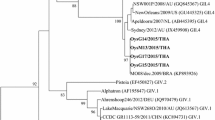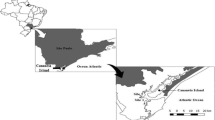Abstract
Norovirus (NoV) is considered the major causative agent of food poisoning outbreaks in Korea. Most such outbreaks originate from vegetables or drinking water, but bivalves are known to be an important NoV vector. Environmental contamination of NoV in ground and river water has been reported in Korea, but the NoV contamination status of shellfish-growing areas based on regular surveys is not available. In this study, we investigated the NoV contamination status of oyster-growing areas in the Jinhae Bay of Korea to evaluate the circulation of various NoV genotypes. A total of 39 NoV-positive samples detected from February, 2010 to February, 2011 were sequenced and evaluated. Based on the sequencing results, five genotypes (GI.1, GI.2, GI.5, GI.6, and GI.7) were identified in NoV GI, and seven genotypes (GII.2, GII.3, GII.4, GII.7, GII.12, GII.13, and GII.17) in NoV GII. GI.1 (52.6%; 10 of 19). Both GII.3 and GII.4 (30.0%; 6 of 20, respectively) were identified as the most prevalent GI and GII strains in oyster during the investigation period.
Similar content being viewed by others
References
Koopmans M, Duizer E. Foodborne viruses: An emerging problem. Int. J. Food Microbiol. 90: 23–41 (2004)
Rutjes SA, Lodder-Verschoor F, Van Der Poel WHM, Van Duijnhoven YTHP, de Roda Husman AM. Detection of noroviruses in food: a study on virus extraction procedures in foods implicated in outbreaks of human gastroenteritis. J. Food Prot. 69: 1949–1956 (2006)
Kim EJ, Cheon DS, Jeong HS, Park SH, Kim CK, Choi SS, Oh SA, Cho SJ, Han KY, Kim MY. Genetic diversity of norovirus in outbreaks of gastroenteritis in Seoul. Food Sci. Biotechnol. 19: 1089–1092 (2010)
Bae JY, Lee JS, Shin MH, Lee SH, Hwang IG. Effect of wash treatments on reducing human norovirus on iceberg lecttuce and perilla leaf. J. Food Prot. 74: 1908–1911 (2011)
Kim SH, Cheon DS, Kim JH, Lee DH, Jheong WH, Heo YJ, Chung, HM, Jee Y, Lee JS. Outbreaks of gastroenteritis that occurred during school excursions in Korea were associated with several waterborne strains of norovirus. J. Clin. Microbiol. 43: 4836–4839 (2005)
Moon A, Hwang IG, Choi WS. Prevalence of norovirus in oyster in Korea. Food Sci. Biotechnol. 20: 1151–1154 (2011)
Lees D. Viruses and bivalve shellfish. Int. J. Food Microbiol. 59: 81–116 (2000)
Formiga-Cruz M, Allard AK, Conden-Hansson AC, Henshilwood K, Hernroth BE, Jofre J, Lees DN, Lucena F, Papapetropoulou M, Rangdale RE, Tsibouxi A, Vantarakis A, Girones R. Evaluation of potential indicators of viral contamination in shellfish and their applicability to diverse geographical areas. Appl. Environ. Microbiol. 69: 1556–1563 (2003)
Beuret C, Baumgartner A, Schluep J. Virus-contaminated oysters: a three-month monitoring of oysters imported to Switzerland. Appl. Environ. Microbiol. 69: 2292–2297 (2003)
Formiga-Cruz M, Tofino-Quesada G, Bofill-Mas S, Lees DN, Henshilwood K, Allard AK, Conden-Hansson AC, Hernroth BE, Vantarakis A, Tsibouxi A, Furones M, Papapetropoulou MD, Girones R. Distribution of human virus contamination in shellfish from different growing areas in Greece, Spain, Sweden, and the United Kingdom. Appl. Environ. Microbiol. 68: 5990–5998 (2002)
Guyader FL, Haugarreau L, Miossec L, Dubois E, Pommepuy M. Three-year study to assess human enteric viruses in shellfish. Appl. Environ. Microbiol. 66: 3241–3248 (2000)
Pina S, Puig M, Lucena F, Jofre J, Girones R. Viral pollution in the environment and in shellfish: Human adenovirus detection by PCR as an index of human viruses. Appl. Environ. Microbiol. 64: 3376–3382 (1998)
Shieh YC, Baric RC, Woods JW, Calci KR. Molecular surveillance of enterovirus and norwalk-like virus in oysters relocated to a municipal-sewage-impacted Gulf estuary. Appl. Environ. Microbiol. 69: 7130–7136 (2003)
Nishida T, Kimura H, Saitoh M, Shinohara M, Kato M, Fukuda S, Mikami T, Munemura T, Kawamoto A, Akiyama M, Kato T, Nishi K, Kozawa K, Nishio O, Detection, quantification, and phylogenetic analysis of noroviruses in Japanese oysters. Appl. Environ. Microbiol. 69: 5782–5786 (2003)
Lee KJ, Mok JS, Song KC, Yu HS, Jung JH, Kim JH. Geographical and annual variation in lipophilic shellfish toxins from oyster and mussels along the south coast of Korea. J. Food Prot. 74: 2127–2133 (2011)
Sim KB, Ha KS, Yu HD, Lee TS, Kim JH. Sanitary survey report in Yongnam-Kwangdo area in Korea (2007–2009). Southeast Fisheries Institute, National Fisheries Research and Development Institute. Tongyoung Korea. pp. 1–90 (2010)
Lee C, Kim SJ. The genetic diversity of human noroviruses detected in river water in Korea. Water Res. 42: 4477–4484 (2008)
Lee, SG., Jheong WH, Suh CI, Kim SH, Lee JB, Jeong YS, Ko G, Jang KL, Lee GC, Paik SY. Nationwide groundwater surveillance of noroviruses in South Korea, 2008. Appl. Environ. Microbiol. 77: 1466–1474 (2011)
Ha S, Woo GJ, Hwang IG, Choi WS. Development of a virus elution and concentration procedure for detecting norovirus in oyster, Food Sci. Biotechnol. 18: 1150–1154 (2009)
Lee CH, Cheong SR, Lee HJ, Kwon MY, Kang IN, Oh EG, Yu HS, Shin SB, Kim SJ. Evaluation of the sensitivity and specificity of primer pairs and the efficiency of RNA extraction procedures to improve noroviral setection from oysters by nested reverse transcription-polymerase chain reaction. J. Microbiol. 48: 586–593 (2010)
Kronneman A, Vennema H, Deforche K, Avoort H, Penaranda S. An automated genotyping tool for enterovirus and norovirus. J. Clin. Viol. 51: 121–125 (2011)
Zheng DP, Widdowson MA, Glass RI, Vinje J. Molecular epidemicology of genogroup II-genotype 4 noroviruses in the united states between 1994 and 2006. J. Clin. Viol. 48: 168–177 (2010)
Roda Husman AM, Lodder-Verschoor F, Berg HHJL, Le Guyader FS, Pelt H, Poel WHM, Rutjes SA. Rapid virus detection procedure for molecular tracing of shellfish associated with disease outbreak. J. Food Prot. 70: 967–974 (2007)
Nishida T, Nishio O, Kato M, Chuma T, Kato H, Iwata H. Kimura H. Genotyping and quantitation of noroviruses in oyster from distinct sea areas in Japan. Microbio. Immunol. 51: 177–184 (2007)
Uhrbrand K, Byrmel M, Maunula L, Vainio K, Trebbien R, Norrung B, Schultz AC. Evaluation of a rapid method for recovery of norovirus and hepatitis A virus from oyster and blue mussels. J. Virol. 169: 70–78 (2010)
Katayama H, Shimasaki A, Ohgaki S. Development of a virus concentration method and its application to detection of enterovirus and norwalk virus from coastal seawater. Appl. Environ. Microbiol. 68: 1033–1039 (2002)
Lee C, Kim SJ. The genetic diversity of human noroviruses detected in river water in Korea. Water Res. 42: 4477–4484 (2008)
Liu LJ, Liu W, Liu YX, Xiao HJ, Jia N, Liu G, Tong YG, Cao WC. Identification of norovirus as the top enteric viruses detected in adult cases with acute gastroenterities. Am. J. Trop. Ned. Hyg. 82: 717–722 (2010)
Kim NH, Min SK, Park EH, Park YK, Jin SH, Ryu BS. Study on gastroenteric norovirus genotypes in Busan, Korea, from 2008 to 2010. The annual report of Busan Metropolitan city Institute of Health & Environment 20: 9–17 (2010)
Food Standards Agency UK. Investigation into the prevalence, distribution and levels of norovirus titre in oyster harvesting areas in the UK. Available from: http://www.foodbase.org.uk. Accessed Jul. 10, 2012.
Korean Food and Drug Administration. Food poisoning outbreak statistics. Available from: http://www.kfda.go.kr/e-tate. Accessed Jul. 10, 2012.
Simonet J, Gantzer C. Degradation of the poliovirus 1 genome by chlorine dioxide. J. Appl. Microbiol. 100: 862–870 (2006)
Hot D, Legeay O, Jacques J, Gantzer C, Caudrelier Y, Guyard K, Lange M, Andreoletti L. Detection of somatic phages, infectious enteroviruses and enterovirus genomes as indicators of human enteric viral pollution in surface water. Water Res. 37:4703–4710 (2003)
EFSA Panel on Biological Hazard. Norovirus (NoV) in oysters: Methods, limits, and control options. EFSA J. 10: 2500–2538 (2012)
Author information
Authors and Affiliations
Corresponding author
Rights and permissions
About this article
Cite this article
Shin, S.B., Oh, EG., Yu, H. et al. Genetic diversity of noroviruses detected in oysters in Jinhae Bay, Korea. Food Sci Biotechnol 22, 1–8 (2013). https://doi.org/10.1007/s10068-013-0237-z
Received:
Revised:
Accepted:
Published:
Issue Date:
DOI: https://doi.org/10.1007/s10068-013-0237-z




